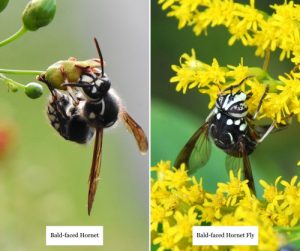(Photos and story by Anita Fernandez)

The Bald-faced Hornet Fly is a syrphid fly, commonly referred to as a flower fly because they feed on nectar as adults, or a hover fly because of their ability to hold still in flight. They, like the Bald-faced Hornet, are pollinators and their larvae also help eradicate aphid pests from gardens. However, unlike the wasp species, the Bald-Faced Hornet Fly does not create a paper wasp or nest colonially, meaning that it is less aggressive. Also, although the fly mimics the wasp, they are unable to sting like a wasp.
A key difference in their identification is in the eyes. Both are white and black, but the eyes of the Bald-faced Hornet are elongated and curved, whereas the eyes of the Bald-faced Hornet Fly are more rounded and set close together. Another distinguishing feature is that flies have only two wings, or one set, whereas wasps have four total wings, or two sets. This can be a difficult feature to determine on these often-moving insects, especially during flight.
